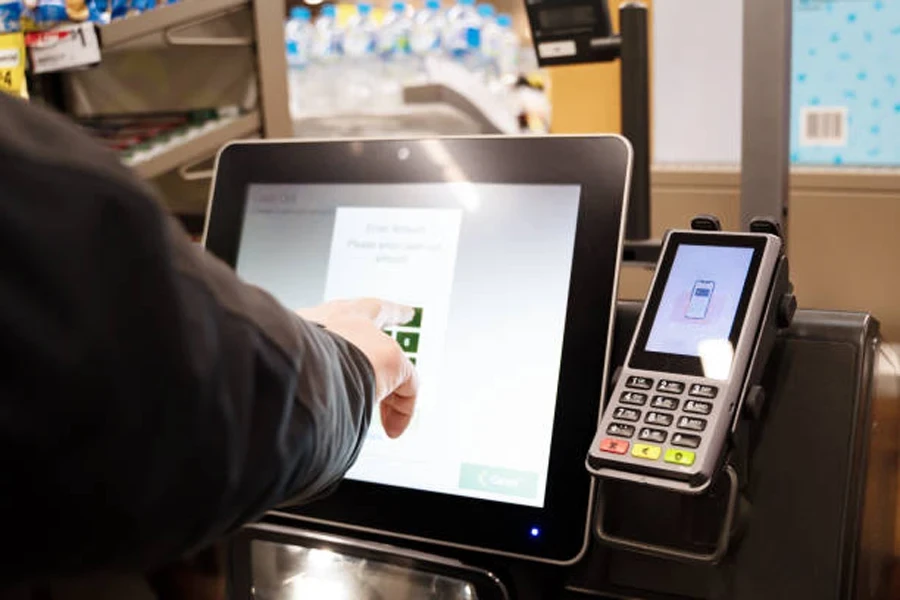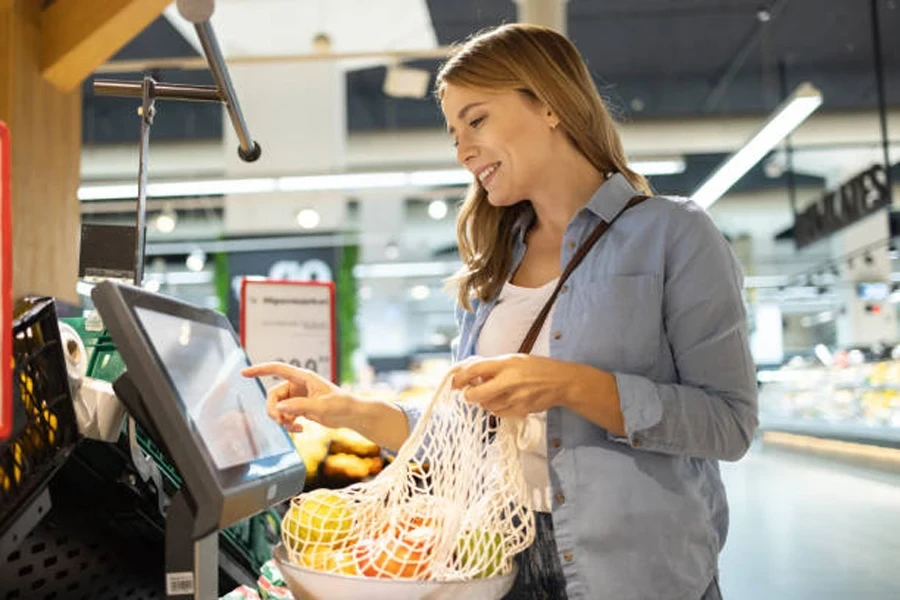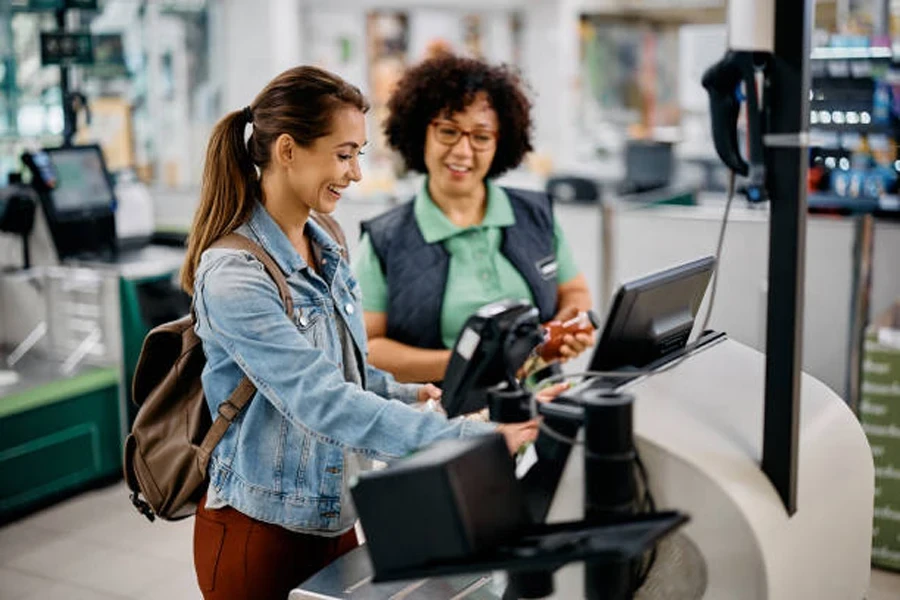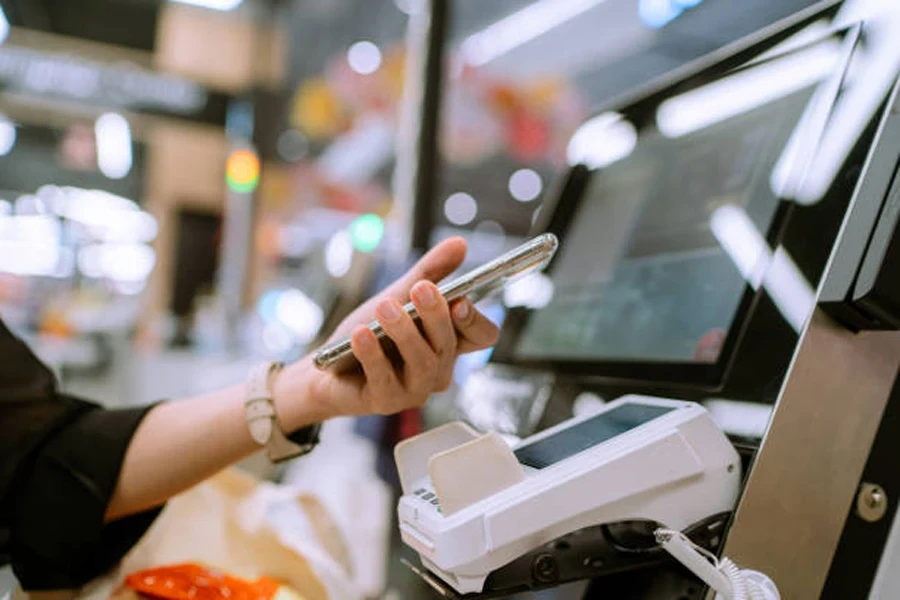As more people seek faster and easier shopping experiences, it’s no surprise that self-checkout systems have become popular. Although they started as a rare option for fancy businesses, the lockdown era pushed retailers to expand these systems quickly. This is partly because their touch-free design made them much more attractive than traditional checkout lanes.
According to Bizrate Insights, 47% of people use self-checkouts regularly, and 31% have tried them before. However, self-checkouts aren’t a guaranteed solution for a smooth shopping experience. The success of these systems depends on careful implementation and choosing the proper store setup—among other factors.
This article will serve as a guide for businesses hoping to add self-checkouts to their store. It will provide everything they should know before installing these systems.
Table of Contents
Self-checkout: How do these systems work?
What are the pros and cons of self-checkout systems?
What are the types of self-checkout machines?
8 tips to help small businesses implement self-checkout systems
Bottom line
Self-checkout: How do these systems work?

Self-checkout systems are automated tools that let customers handle their purchases without needing help from a cashier. These systems are especially common in busy retail stores with many customers and many-item purchases, like grocery, convenience, and large chain stores (like Walmart and Dollar General).
How do they work?
Self-checkout (or assisted-checkout) systems use advanced technology to handle key tasks like:
- Scanning items with barcode readers.
- Weighing items like fruits and vegetables.
- Applying any coupons or discounts.
- Making sure customers place scanned items correctly in the bagging area.
- Processing payments.
While these systems can work independently, many stores still have a couple of staff members nearby to assist if needed. The system also alerts employees when help is required. Additionally, self-checkouts often come with security features like cameras and weight sensors to ensure everything runs smoothly and securely.
What are the pros and cons of self-checkout systems?
Benefits of self-checkout systems
Self-checkout stations have two main attractions. First, they aim to make shopping more convenient by shortening wait times. Second, they can help stores save on labor costs by reducing the need for staffed checkout lanes. However, some experts still emphasize the need to balance self-checkout and traditional lanes, depending on how crowded the store is.
Downsides of self-checkout systems
Self-checkout systems may have many enticing benefits, but retailers must also understand the risks and downsides. Here are some cons businesses can expect to face with these systems.
- Risk of theft: Self-checkout systems can lead to more inventory loss and shoplifting. For example, someone might scan a cheaper item’s barcode, weigh a different item, or slip an unscanned item into their bag.
- A less personal shopping experience: Some shoppers feel that not interacting with a cashier makes them feel distant and lonely while shopping. Cashiers can answer questions or help with issues like defective items right away. That “human touch” is missing with self-checkouts.
- System glitches: Self-checkout systems can encounter problems, such as items not scanning properly or not being recognized in the bagging area. Even though staff are usually nearby to help, these tech issues can annoy employees and customers.
What are the types of self-checkout machines?

1. Kiosks
Self-checkout kiosks are becoming a go-to choice, especially in grocery and convenience stores. These kiosks let customers check out on their own, just like they would with a cashier. This self-checkout option will let consumers scan barcodes (with a digital or handheld scanner) or type the item name to find it in the system. Additionally, customers can use various payment methods, including debit/credit cards, cash, or digital wallets.
2. Scan-and-go
While kiosks are popular, scan-and-go systems offer an even faster option. Shoppers use a handheld scanner to scan items as they shop, then dock the device at checkout, where everything is already recorded. This way, they can quickly pay without rescanning anything.
3. Mobile apps
Recently, scan-and-go technology shifted to smartphones. Customers can now use their phone’s camera and a store’s app to scan items as they shop. Some stores let users pay directly through the app, skipping checkout lines altogether, while others require scanning a QR code at self-checkout.
4. RFID
RFID self-checkout uses tags on items that scanners read to process purchases. Some systems require placing items in a specific area to scan and pay, but others go further, letting customers walk out while the store charges them automatically. With AI advancing fast, many stores are testing “smart carts” for even more seamless shopping.
8 tips to help small businesses implement self-checkout systems
Tip #1: Access business needs first and choose the right self-checkout solution
Don’t just rush into investing in self-checkouts. Businesses must first determine what system best suits their store and customers. And the first thing to do here is to identify any pain points in the store’s current setup.
Are long lines an issue during peak times? Self-checkout kiosks can ease congestion. What if retailers want to reduce labor costs? Self-checkout is an excellent option, but remember that stores still need staff to assist customers and monitor them for theft.
The second thing businesses must do is consider their customer demographics. For instance, if most shoppers are older, they may prefer traditional checkouts. So, offering a mix of options could be the best approach. This way, retailers won’t need to convert their entire store to self-checkout lanes.
Tip #2: Integrate it with existing infrastructure

As mentioned earlier, any self-checkout system businesses choose must seamlessly integrate with their existing POS system and payment gateway without needing a complete tech overhaul. The system should also connect with the retailer’s analytics and reporting tools to help measure its success.
Remember to integrate loyalty programs and CRMs to enhance the customer experience. More importantly, businesses should work closely with their provider to ensure the smoothest implementation possible. A good idea is running test transactions to help staff learn the setup and ensure everything—from the scanner to the POS and payment processor—works correctly.
Tip #3: Set payments for the self-checkout machines
Like regular checkouts, self-checkout machines must offer various payment options to keep the process convenient and appealing. Customers expect to pay with cash, debit/credit cards, or contactless methods. Hence, limiting these options can frustrate users and make self-checkout less attractive.
Self-checkouts must also comply with data protection regulations. Retailers must ensure that security features like encryption and tokenization protect customers’ payments and information during transactions.
More importantly, businesses can choose how they will offer these payment options. Since most customers prefer using cards, they may set up only a few kiosks to accept cash, allowing supervisors to monitor them more closely for smoother transactions.
Tip #4: Consider the user’s experience and accessibility

Ease of use is another crucial consideration for self-checkout systems. If the store struggles with long lines, a confusing checkout process will only worsen things. The self-checkout system should guide customers through each step, with simple prompts for scanning items and placing them in the bagging area.
Large icons and on-screen texts should also help customers find help or make payments easily. Retailers should also ensure kiosks are accessible to everyone, with options for different heights and mobility needs. Ideally, they should include features like voice overs, high-contrast screens, and multiple language options.
Tip #5: Increase security and use loss prevention strategies
A major downside of self-checkouts is the potential for intentional or accidental theft, leading to inventory loss. While some customers may scan the wrong item by mistake, others could exploit the system to pay less. Thankfully, combating this issue is not very hard.
Retailers can use various security measures like video surveillance, checkout supervisors, and AI to detect suspicious behavior. Some stores (like Target) even limit the number of items per transaction to reduce fraud.
However, these measures can negatively impact the shopping experience, making customers feel watched or causing frustration with frequent interruptions. That’s why businesses must balance these security measures with a positive customer experience.
Tip #6: Test and gather feedback
Before fully rolling out a self-checkout system, testing it in a few store areas is wise. Businesses can set up one or two kiosks and have a staff member oversee them while collecting customer feedback. This data helps retailers monitor demand and gather insights into customers’ thoughts about using self-checkouts.
Key metrics, like transaction time, number of items, and the need for manual help, should also be monitored. If self-checkout is taking longer than expected or causing issues, it may mean that the system isn’t improving the checkout process as hoped. This test phase will allow retailers to make adjustments before a full-scale implementation.
Tip #7: Implement a rollout and marketing plan

After choosing a self-checkout system, retailers must plan a smooth transition and build excitement among customers. Here’s a great place to start: use a phased rollout by introducing a few self-checkout lanes before expanding. This approach lets businesses test the system, train staff, and address issues gradually.
Next, retailers should refine the system with initial feedback from a small group of customers. When everything is ready, they can promote self-checkout benefits (like shorter lines and faster transactions) through in-store signage, staff recommendations, and social media. Additionally, they can educate customers on how self-checkout enhances their shopping experience to increase interest and adoption.
Tip #8: Always maintain and upgrade
The process doesn’t end after setting up self-checkout systems. Businesses must maintain their new systems with regular software updates, cleaning, and security checks. Remember to monitor innovations that could enhance the experience, like improved accessibility, better loyalty program integrations, or paperless options for a greener approach.
Bottom line
Self-checkouts may have become popular during the lockdown era, but they still offer great benefits. In addition to reducing wait times and making the checkout process smoother, self-checkouts free up resources for other areas of the business.
However, if retailers don’t implement them well, self-checkouts can frustrate customers and drop their value. By following the tips discussed in this article, businesses can ensure that their self-checkout system meets customer needs and is set up effectively.



